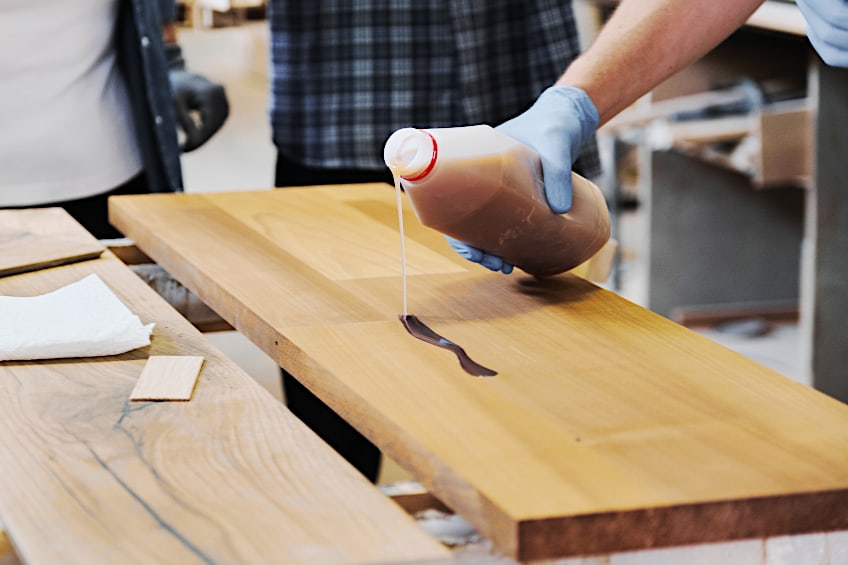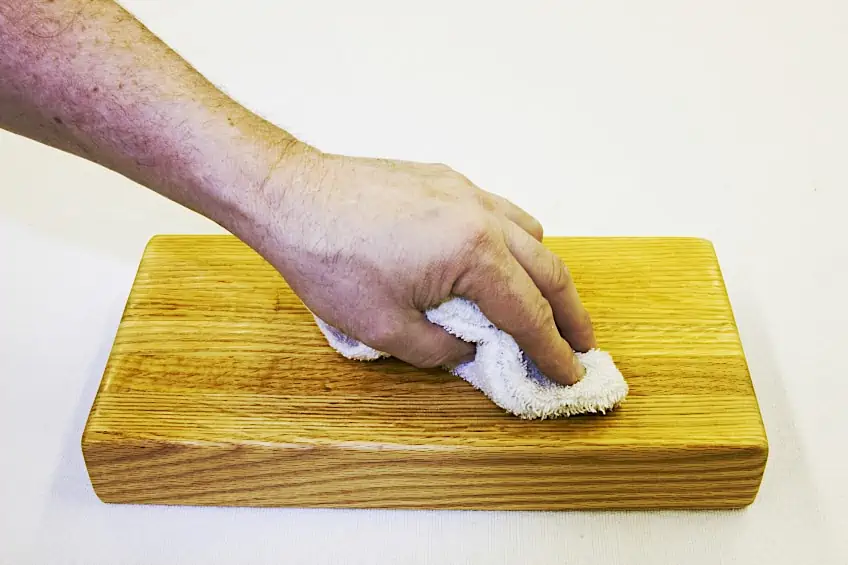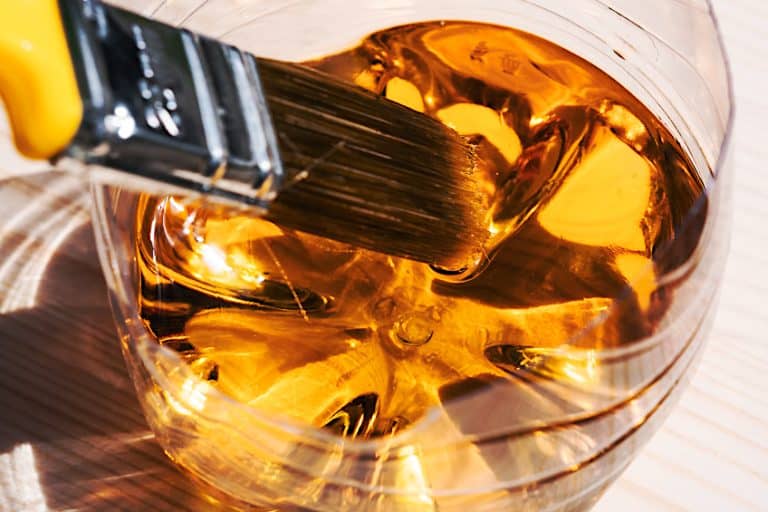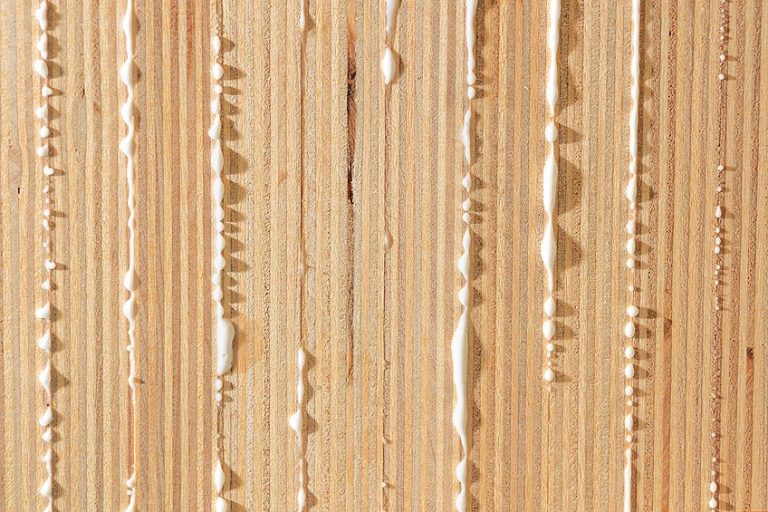Tung Oil vs. Linseed Oil – Which Natural Oil is Best for Wood?
With the recognition of our effect on the environment, we have all made considerable changes to the way we live, the products we buy, and what we do with our waste. This realization has reshaped society and how we look at our everyday lives, down to the smallest of details. In the crafting industry, this has affected everything from plastics and resins to the types of adhesives and wood treatments we use. Wood treatments in particular have seen a huge change in the popularity of all-natural wood treatments like Tung and linseed oils. Many DIY weekend warriors and professional craftsmen alike have switched from products like a varnish to these non-toxic wood treatments, but what are they? Let’s have a look at what exactly these treatments are and how they stack up against one another.
What Is Tung Oil?
What is Tung oil? Tung oil is one of the most sought-after wood treatments on the face of the planet. This oil is derived from the sap of the Tung tree which is found mainly in China and its surrounding regions. This oil is deeply entrenched in the woodworking and general crafting culture of the region, being used to create a water-resistant coating for furnishings, boats, stone sculptures, and many other surfaces in the region for many years.

If you’re wondering why this particular oil has such a large fanbase we don’t blame you. This oil is one of the most versatile and effective wood treatments products on the market today, allowing you to both protect your workpiece and increase its aesthetic appeal with a single product.
You may well argue that varnish and other synthetic products allow you to do the same thing, right? Well, yes, they do, but the difference between Tung oil and the aforementioned products is that you have all the benefits of protecting your workpiece and beautifying it without the drawback of introducing harmful chemicals to your workpiece and more importantly yourself.

That’s right, Tung oil is all-natural and has no adverse effects on your workpiece, your health, or the environment for that matter! Tung oil is pretty easy to come by and you might have even seen it on sale at your local lumber supplier or crafting store, but not all variations of the wood treatment oil are created equal.
Tung oil comes in two variations, one that contains a synthetic drying agent and one that does not. As the name implies, Tung oil products that contain a drying agent dry faster, but the chemicals used to achieve the accelerated drying rate can be harmful to you and the environment.
Pure Tung oil can be a bit more challenging to come by and might be a bit more expensive compared to the ones containing the drying agent, on the other hand, more and more companies are opting to use more environmentally friendly drying agents or simply refraining from using these chemicals in their products entirely.

This being said, Tung oil’s popularity is due to a combination of factors. Tung oil is one of the more versatile substances out there for finishing and protecting a wide variety of surfaces, all of which benefit from its ability to protect it from exterior forces, not to mention make them food safe, waterproof, and safe from things like mold and insect infestation. How does Tung oil do this? Well. It works in the same way varnish does by penetrating beneath the surface of the workpiece and bonding with the wood fibers, which forms the protective layer we discussed previously.
What Is Linseed Oil?
What is linseed oil? You might have seen this coating on the shelves of your local hardware store during a woodworking tutorial video. Either way, there are those in the crafting industry that pretty much swear by this amazing finishing oil, but what exactly is linseed oil, and what makes it so popular?
Funnily enough, linseed oil does not come from the linseed plant, in fact, there is no such thing as a linseed plant, rather, it is derived from a plant known as the “flax” plant. Linseed oil is not derived from the plant itself, rather from the seeds of the plants which can be pressed and squished to get the sweet, sweet linseed oil that they produce naturally.

Linseed oil is pretty cool because when it dries it tends to crystallize into something that resembles honeycombs, and what makes it even cooler is the fact that it works as a natural drying agent. Drying agents are used to reduce the water in a given substance to zero which means that it allows surfaces (or itself for that matter) to dry quickly after application to a given surface.
Although linseed is used on its own in the woodworking and crafting industry it can also be used with other substances to provide them with its own properties or to provide the linseed oil itself with additional properties as needed. Did we mention that linseed oil is also an edible oil? Although this isn’t common practice all over the world, linseed oil is consumed mostly in eastern European regions where it is eaten alongside Quark, which is essentially aged dairy that is coated in flax oil and consumed as a sort of delicacy.

Linseed oil in its “flax oil” variation can serve as a culinary oil which is 100% fit for consumption, and what’s more is that it is a potent (although small) source of Omega three which means it’s good for you too!.
Linseed oil has many applications which span many industries. For example, in the paint industry, linseed oil is sometimes used as a binding agent to chemically bind various elements of a given paint product together to make it cohesive, multi-purpose paint.
Even though it is very popular in the woodworking industry it is not a particularly good protector of wood workpieces, finding that things like water and water vapor pass right through this wood treatment with relative ease. Another factor counting against this oil is the fact that it can be easily scratched and easily removed, but on the other hand, it can also be very easily re-applied, making maintenance pretty easy in the long run.

Despite its drawbacks, linseed oil provides an absolutely wonderful finish to the workpieces it is applied to. When applied to wooden surfaces it provides a deep penetrating finish that leaves the wood’s surface with a sheen, intense finish which can be singled out from a mile away.
Tung Oil vs. Linseed Oil: How do They Differ?
In the battle of Tung oil vs linseed oil, there are lots of factors to consider. There are a few key differences between Tung oil and linseed oil, and although both oils are extremely versatile and effective when they are applied as wood treatment, they have their limitations and drawbacks. Let’s see how these two oils stack up against one another.
| Characteristic | Linseed Oil | Tung Oil |
| Impact on Color | Causes wood to orange with age Amplifies woods natural color | Increases intensity of wood color while lightening overall surface aesthetic Highlights the woods grain |
| Water Resistance | Inherently water resistant | More water resistant than linseed oil Chemical composition has tightly packed bonds which repel water Virtually waterproof |
| Resistance to Infestation | Boiled linseed oil typically repels insects | Natural Tung oil is resistant to insects and water |
| Cost | Inexpensive | Inexpensive |
| Availability | Readily available | Readily available but not as commonly sold as linseed oil |
| Quality of Finish | High quality finish and resistance to damage Pure Linseed oil is food safe “Flax oil” variation is edible | Good finish High resistance to abrasion and impact Increases hardness or wooden surfaces Food safe |
| Versatility | Extremely versatile Works on any virtually all densities of wood Flax oil variant is edible | Extremely versatile Can be used on virtually any wood as well as stone |
| Dry time | Absorbed faster than Tung oil when boiled linseed oil is used Raw linseed oil cures much slower | Slow cure time Cures faster if less oil is applied Applying oil in thin coats can decrease drying time |
What Are the Pros and Cons of Linseed Oil and Tung Oil?
Now that we know the key differences between the contestants in the linseed oil vs Tung oil battle let’s have a look at some of the pros and cons of each of them. You might find that one works better than the other for certain applications, so be sure to choose one that suits your particular needs as used for these oils are highly subjective.
Linseed Oil Pros and Cons
Being of the most used oils on the face of the plant for decades, linseed oil has an almost cult-like following that spans entire nations. What makes this oil such a fan favorite though? Let’s have a look at some of its pros and cons so you can see for yourself.
- Enhances the natural texture of wood
- Accentuates the wood’s grain
- Non-toxic
- Food safe
- Deep penetrating oil
- Protects wood from moisture
- Can be used in conjunction with other finishes
- Needs to be reapplied from time to time
- Surfaces are at greater risk of impact or abrasion damage
- Surfaces abrasion can be challenging to repair compared to other coatings
- Wooden surfaces can turn yellow if not maintained correctly
- Abrupt temperature changes can cause saturated wood to express excess oil
- May not protect wood against inadvertent staining if not re-applied regularly
Tung Oil Pros and Cons
Lung oil has been used in the east for (with no exaggeration) hundreds of years. In many eastern regions the practice of using tung oil on fishing vessels and sports equipment has been passed down from generation to generation, so let’s see what all the fuss is about and have a look at some of the pros and cons of this oil.
- Pure Tung oil is non-toxic
- Pure Tung oil is food safe
- Easy to apply with brush or cloth
- Readily available
- Easy to re-apply and maintain when applied to workpieces
- Resistant to water and ambient moisture (more so than linseed oil)
- Can be used on stone and wood surfaces
- Although resistant to water it is not waterproof
- Can be scratched or damaged by impact (although less so than linseed oil)
- More expensive than linseed oil
- It may require more than one coat for the effect to be noticeable (much more than linseed oil)
How to Apply Linseed Oil or Tung oil
At this point in the linseed oil vs Tung oil debate, you should have a pretty good idea of which wood treatment oil is best for you. What many would-be crafters tend to lack is the knowledge of how to use these wood treatments, therefore we’ve decided to give you a short tutorial showing you how to use these oils effectively. Remember that whether you choose linseed or Tung oil, your finish will come down to how well you apply the oil to your workpiece.

Tung and linseed oil have become really popular recently. If you’re interested in using some on your latest workpiece, here is a short step-by-step guide for you to use on the off chance you don’t want to sit through a 20-minute YouTube video filled with ads. (Still, we did include some video tutorials at the end of this article, just in case you really want to know more).
Prepare Your Surface
Whether you choose to use linseed or Tung oil you will need to prepare the surface of your workpiece to receive the wood treatment. Linseed oil works best on a surface that has been prepared with fine-grit sandpaper, preferably 120 grit or finer to ensure that wood fibers are nice and smooth so they will not catch on your cloth or brush.

Take as much time as you need when preparing wood for oil. Ensure that the surface is not only ready to receive the oil but also uniformly even. Clear your workpiece of any stray dust and wood particles before moving on to the next step in the process.
Dilute Your Linseed Oil or Tung Oil (Optional)
Linseed oil and Tung oil can be really thick the first time they’re used. This being said, lots of professional crafters and DIY enthusiasts have found that diluting either two oils with citrus solvent can assist in the application process.

Citrus solvent works by changing the viscosity of the oils, it is able to penetrate the surface of the workpiece easier, which means you won’t spend much time cleaning up blotchy areas on your workpiece once it’s been rubbed in.
How do you blend citrus solvent with natural oils? Simply pour some linseed or Tung oil into a container of your choice and add the citrus solvent to the substance as needed until you achieve the desired viscosity.
Apply Your First Coat
Now for the part where you get your hands dirty. You have two choices when applying these oils, you can either apply it with a brush or a cloth. Each applicator has its own advantages and disadvantages, using a brush means that you have a faster and more uniform application of your coat, but using a cloth means that you have the advantage of rubbing the oil in while applying it, but you will sacrifice speed and uniformity in the oil’s application.

This is a purely subjective choice, simply choose which one suits you best and get going, using a brush is simple, simply start from one end of your workpiece and work your way to the other, whereas if you choose to use a cloth, you should work from the center of the workpiece and work your way outward toward the edges.

You can choose whether to pour the linseed oil directly onto the workpiece, or to apply it with a cloth or paintbrush This won’t seriously affect the overall finish, but it might be easier to manage, depending on your skill and comfort levels.

Allow Time for Absorption
Congratulations! You’ve successfully applied your first natural wood treatment to your workpiece, but even though the most challenging part is done, you still need to make sure that your finish looks good. How do you do this?
Allow the linseed or Tung oil to be absorbed into the wood for roughly 15 to 20 minutes at room temperature. Then remove any excess oil that has not been absorbed into the wood’s surface with a cloth. Why? Well, linseed oil, in particular, can become quite sticky if too much is applied to a wooden surface.

Once you are sure that all of the excess oil has been removed, allow it to sit for the manufacturer’s recommended time period. If you aren’t satisfied with the color just yet, simply sand the surface down lightly with fine-grit sandpaper and repeat the process until you have achieved your desired hue. Remember that Tung oil will require more coats than linseed, so don’t be discouraged if your first coat isn’t what you pictured it would be.
Now that you know the difference between linseed oil and Tung oil, what the two look like when they are compared side by side, what the pros and cons of each oil are, and how to apply them effectively, it’s time for you to get out there and put your newfound knowledge to the test. Remember that these oils come in many variations, so always ensure that you check whether you’re dealing with a 100% natural variant, or one with additives.
Frequently Asked Questions
What Is the Difference Between Linseed Oil and Tung Oil?
These two oils have similar applications, but they have a few key differences. They are derived from different plant seeds, Tung oil needs more coatings and is naturally water and insect repellent, whereas linseed oil is only water-resistant and insect repellent once boiled. Both oils are extremely versatile, Tung oil can be applied to stone, but pure linseed oil is also edible.
Does Linseed Oil Work on Cedar?
Linseed oil on cedar works surprisingly well. Most professional crafters would recommend rubbing your linseed oil in by hand instead of using a brush, this allows it to soak in and bond with the wood’s fibers more effectively, producing a healthy glow without compromising the wood’s grain in the process.
What Are Good Tung Oil Alternatives?
Looking for Tung oil alternatives? The most common Tung oil alternative is linseed oil. Linseed oil is derived from the flax plant and can be used as a wood treatment oil. This oil provides a great finish and does not need to be applied as generously as Tung oil.

I have been into woodworking since 2005 and woodturning since 2011. Because of my love for wood and woodworking, I started woodhappen.com to teach other enthusiasts about how to finish and seal wood, the best woodworking tools, the different types of wood, and everything else related to woodworking! Read more about me here.







